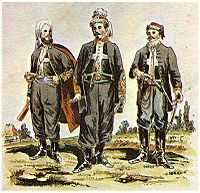Zouaves of Death
| Zouaves of Death | |
|---|---|
 Zouaves of Death. Colonel François Rochebrune in center. | |
| Active | 1863 |
| Country | Poland, Congress Poland |
| Type | Light infantry |
| Motto | "Victory or death" |
| Colors | Black and white |
| Engagements | Miechów, Chroberz, Grochowiska, Krzykawka, Pobiednik Mały |
| Commanders | |
| Notable commanders | François Rochebrune |
Zouaves of Death (Polish: Żuawi śmierci) were a Polish military unit during the January Uprising, formed in February 1863 from volunteers in Ojców, Poland, by the French officer François Rochebrune (Polish: Franciszek Rochebrune). Rochebrune based the formation on the French light infantry regiments in the French Army, the Zouaves, in which he had served during the Crimean War.[1][2]
Name
The name of the unit referred to the original French formations, initially recruited from a particular tribe of the Berbers, the Zouaoua of North Africa, in French Algeria in the 1830s. The "of death" portion of the name referenced the oath that the members of the unit were required to swear upon being accepted, which stated that the only outcome of the military engagements that the unit was to participate in was "either victory or death".[2]
History


The formation was known for its distinctive and elaborate uniforms, also based on that of the Algerian Zouaves,[3] which consisted of a cotton shirt, a vest made of elk hide, a black silk robe, a collarless black silk frock coat, puffy hose, a black and white scarf, knee high leather boots, a red fez with a ram skin brim and a distinctive large embroidered white cross on the chest.[4][5]
The identifying standard of the unit reflected the uniform; it was a black banner with a white cross, surrounded by red and white (national colors of Poland) embroidery with the motto W imię Boże - r. 1863 ("In the name of God - 1863").
The unit's baptism by fire occurred at the Battle of Miechów, where under the command of adjutant Wojciech Komorowski,[4] they successfully charged Russian forces defending the local cemetery.[3] However, the overall engagement was a defeat for the Poles. In the Battle of Chroberz the Zouaves covered the retreat of the main body of Polish forces under Marian Langiewicz. They also fought at the follow-up Battle of Grochowiska where they captured Russian artillery positions but suffered very high casualties.[6] In that engagement Langiewicz lost control over the overall deployment of forces, and it was Rochebrune who assumed command and successfully managed the retreat.[2] As a result he was promoted to the rank of General and, afterward, even nominated for the position of overall leader of the uprising. However, his candidacy was not recognized and, disillusioned with the political infighting which characterized the insurrection Rochebrune left for France.[2]
Another part of the unit, under Cpt. Stefan Malczewski, fought at the Battle of Pobiednik Mały where, significantly outnumbered, they also suffered heavy casualties, in good part because of their refusal to retreat according to their oath. The bodies of the dead Zouaves were buried in a mass grave and the Tsarist authorities decreed that the grave was to be left unmarked. However, local villagers, in defiance of the order, planted four saplings on the corners of the mass grave to commemorate them. Later on, a cement headstone was constructed and a great grandson of one of the Zouaves who died at the battle funded a memorial statue.[2]
Rochebrune returned to the fight in the final months of 1863 but at that point the insurrection had suffered severe military setbacks and Rochebrune returned to France.[2]
Subsequently Rochebrune was awarded the order of Legion of Honour for his part in the Polish uprising by the French government. He remained a strong advocate for the cause of Polish independence while in France. He took part in the Franco-Prussian war in the rank of colonel where he insisted on fighting in his Zouaves of Death uniform at the head of a unit he called Les Gaulois (The Gauls). He was killed in November 1870 by a sniper shot near Saint-Cloud.[6]
After Rochebrune's departure the Zouaves of Death were led for a short time by the second in command, Tytus O'Brien de Lacy (nom de guerre "Grzymała")[7] but for all practical purposes it ceased to exist. A portion of the troops crossed over into Austria, while twenty one of its soldiers remained in Poland and fought, alongside the Garibaldi Legion (Italian volunteers fighting for Poland, organized by Garibaldi's son Menotti Garibaldi and led by Francesco Nullo) at the Battle of Krzykawka.
The Uprising was finally crushed by Russia in 1864.[8]
Włodzimierz Wolski composed a song dedicated to Zouaves, the "March of Zuaves" ("Marsz Żuawów").[9]
References
- ↑ Zofia Gołubiewowa, Halina Blak, Barbara Małkiewicz, Elżbieta Wojtałowa, Modern polish painting: Polish painting of the 19th century, The National Museum, 2001
- ↑ 2.0 2.1 2.2 2.3 2.4 2.5 Bartek Rogalski, "„Żuawi Śmierci” w Powstaniu Styczniowym" (Zouaves of Death in the January Uprising), last accessed 1/14/2011
- ↑ 3.0 3.1 Les Archives de la grande guerre, Volumes 15-16, 1922, pg. 176
- ↑ 4.0 4.1 Józef Białynia-Chołodecki, Dowódcy oddziałów w powstaniu styczniowem i współczesne pieśni rewolucyjne (Unit commanders in the January Uprising and contemporary revolutionary songs), Gubrynowicz i Schmidt, 1907, pg. 67
- ↑ "Legia Cudzoziemska - ojczyzna niechcianych bohaterów " (The Foreign Legion - motherland of unwanted heroes) Polska Times, 10/11/2010, last accessed 1/15/2011
- ↑ 6.0 6.1 Jerzy Kowalczyk, "Grochowiska", Webpage of Muzeum Historii Kielc (Museum of History of Kielce). Last accessed 1/15/2010.
- ↑ Vladimir Anatolievich Diakov, Stefan Kieniewicz, Dokumenty povstancheskikh voenachalʹnikov, PAN, 1976, pg. 311.
- ↑ Tibor Iván Berend, History derailed: Central and Eastern Europe in the long nineteenth century, University of California Press, 2003, pg. 99
- ↑ Bronisław Szwarce (1903). W czterdziestą rocznicę powstania styczniowego, 1863-1903. Komitet Wydawniczy. pp. 508–. Retrieved 24 January 2011.
| Wikimedia Commons has media related to Żuawi śmierci. |
| |||||